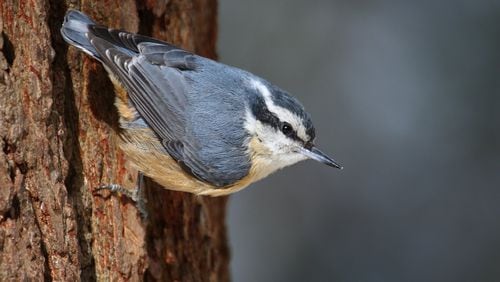To the delight of bird lovers, Georgia is having an "irruption" this winter. Not to be confused with eruption, an irruption is a dramatic, irregular migration of large numbers of birds to areas where they aren't typically found.
The excitement this winter is due to a lively little songbird, the red-breasted nuthatch, which is seldom seen in Georgia except in the highest elevations of the Blue Ridge Mountains. During the past few weeks, reports of seeing the bird in Atlanta and elsewhere in Georgia have exploded — clearly an irruption.
Some Georgia birdwatchers report seeing red-breasted nuthatches for the first time ever this winter. Two of the birds showed up recently at Lee Stanley’s bird feeders in Douglas County to feed on black sunflower seeds. “I’ve been watching my backyard birds for over 20 years and this is my first ever sighting (of red-breasted nuthatches), so it is rather exciting,” Stanley said.
A year-round resident of Canada and certain parts of the Northeast, as well as higher elevations of Appalachia, the Rockies, and along the West Coast, the red-breasted nuthatch’s wintering grounds in the U.S. can fluctuate dramatically year to year, especially in the east. “Typically, the bird remains more northern, but in an irruption year, it can be seen in unusually high numbers throughout the northern and eastern U.S.,” says a National Audubon Society report.
Bird experts say a shortage of spruce seeds, the bird’s primary food, and harsh winter weather up north are probably driving this year’s irruption.
Georgia has two other nuthatch species, the white-breasted nuthatch and the brown-headed nuthatch, which are common and live year-round in the state. The red-breasted is the smallest nuthatch and sports a black-and-white striped face, a slate back, and a tell-tale rusty (not really red) underside.
It is fond of suet and sunflower seeds, so if you provide those foods this winter you also may enjoy a visit from the energetic little bird.
IN THE SKY: From David Dundee, Tellus Science Museum astronomer: The moon will be last-quarter Thursday. Only three planets are visible now: Mercury and brilliant shining Venus, low in the east just before sunrise, and Mars, low in the southwest at dusk.
About the Author






